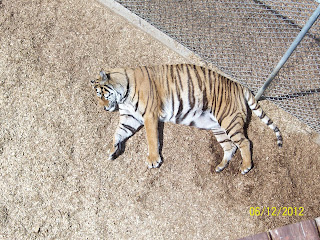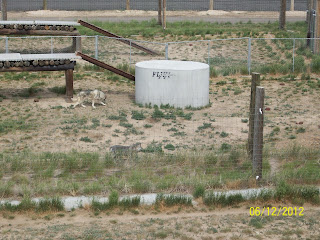The Wild Animal Sanctuary is a true sanctuary for abused, abandoned, exploited and endangered exotic wildlife. The Wild Animal Sanctuary is home to over 290 of the most magnificent creatures on this planet, African Lions, Tigers, Jaguars, Leopards, Mountain Lions, Servals, Bobcats, Wolves and Bears. Here the animals who have suffered abuse, neglect, abandonment, commercialization and exploitation get to "come home" to a wonderful safe haven that provides them with spacious indoor-outdoor living quarters.
Started in 1980 by Pat Craig, a 19 year-old college student who could not condone the killing of healthy animals by zoos, government agencies, and other facilities. The Wild Animal Sanctuary continues today rescuing animals in dire need, rehabilitating them and providing them with an exceptional quality of life. The vast majority of the sanctuary's rescued animals came from official confiscations by law enforcement agencies who had no choice but to intervene on the animals behalf. So many people either failed to care for the animal properly, abused them, or were keeping them illegally.
The problem is large. There are over 30,000 large carnivores being kept privately in the United States today (which means they are outside the zoo system)!
Approximately 15,000 of them are tigers (which is far more tigers than remain in the wild)!
Each day, dozens of these animals become homeless or abandoned and face euthanasia if authorities can't place them in properly licensed facilities.
"The problem is getting out of hand" says Pat Craig, the sanctuary's Executive Director, "as people are beginning to take these animals out into the country side and let them go just like people have done with dogs and cats for many years. These animals can end up killing someone!
The Sanctuary does not breed or sell its animals, nor are they used for commercial purposes. Visitors view the animals on this elaborately constructed viewing system which is a 3/4 mile long elevated walkway. We were able to see the animals from above without disturbing them.
The Wild Animal Sanctuary is a 501 (c) 3 public non-profit sanctuary, and receives no government funding. The annual budget comes primarily from individual donations. As a nearly all-volunteer organization, the money raised goes almost entirely to feed and care for the animals.
Tiger Habitat: Newly rescued Tigers are placed in introduction areas adjacent to the habitat, so they can spend come time getting used to the sights and sounds of the Sanctuary.
It was very hot so the Tigers were relaxing in the shade.
They like to swim and play in the water.
Once new Tigers feel comfortable with their surroundings, and have had a chance to meet the other Tigers through their enclosure fence, then they are released to roam and live freely within the habitat. Some of the Tigers in this habitat weigh nearly 800 pounds, and can live up to 23 years in captivity.
African Lion Habitat: There are two Prides of African Lions that live in the habitat. Newly rescued Lions stay in and introduction area adjacent to the habitat until such time they are adopted by the members of one of the Lion Prides. Once they have been accepted, they are released into the Pride's habitat to live as a cohesive family group.
Lions like the shade in this heat.
This Lion is walking free in the habitat.
Black Bear Habitat: Like the Lions and Tigers the newly rescued Bears are also placed in an introduction pen until they are comfortable with their surroundings then they are released into the habitat. There are more than a dozen Black Bears that live in this 10 acre habitat.
There is a Brown Bear Habitat, if you look closely you can see a Brown Bear in the culvert pipe.
Wolf Habitat: There are two Timber Wolves and two Arctic Wolves in a separate habitat from the Eastern Gray Wolves. There are nearly a dozen Eastern Gray Wolves that live in their 3.5 acre habitat. Eastern Gray Wolves are smaller than normal Gray Wolves, Timber and Arctic Wolves.
They also like the shade.
Bolivian Lion House: This 15,000 square foot building was designed and created to house 25 African Lions that were rescued from Bolivia.
The Lions are housed below this dining area in the Bolivian Lion House. Pam and Kent celebrated their anniversary here at a fund raiser.
Oh, the life of a Bolivian Lion. There would have been more activity if it wasn't so hot.
The Lions came from eight separate circuses after they failed to comply with a new Bolivian law that made it illegal to use animals in circus acts or displays.
The 25 Lions were rescued from Bolivia in conjunction with Animal Defenders International, as well as Game Show Host Bob Barker.
The Lions came to Colorado in February, so this unique building was created to help buffer them from the cold winter weather while they acclimated to their new home.
There were a lot of animals we didn't see because they were hiding in their culverts and shaded areas to keep cool.
It's difficult to show the magnitude of this place with the photos I took. It is so much more spectacular to see this place in person. Bev and I really enjoyed our time with the animals.
Help save some of the most magnificent creatures on Earth. Check them out at: www.WildAnimalSanctuary.org
On the way back home from the Sanctuary we stopped at Pam and Kent's house for supper. Kent is in New Jersey for his job, Elisabeth was with her friends, so it was just Pam, Bev and I. Pam made a great steak dinner cooked to perfection, but I'm sorry Pam, Kevin's steak was better.





















No comments:
Post a Comment